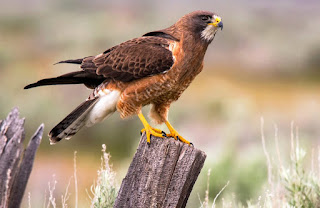
A large group of raptors belonging to the order Falconiformes are collectively referred to as hawks. There are about 270 different species of hawks, with the exception of Antarctica. Hawks can be found in a variety of environments, including marshes, forests, rainforests, prairies, open savannas, grasslands, mountains, and coastal areas. Because chemical pollution causes the eggs of some hawk species to be destroyed, including the Cooper’s hawk, these species are in danger of extinction. The destruction of nesting sites, excessive hunting, and collisions with moving vehicles are additional factors that affect hawk survival in the wild.
The size of hawks varies depending on the species. The American Kestrel, the smallest hawk, only weighs 4 ounces. The Ferruginous Hawk, the largest hawk, can weigh up to 5 pounds. Men are generally smaller than women.
A rough-legged hawk, for example, can grow to a length of 22 inches and a wingspan of 55 inches.
Sharp talons, a big, curved bill, and strong legs define hawks. The prey is bit and torn apart by the sharp bill.
Hawks have very good vision. They have eight times the vision of humans. Hunting is the main application for eyesight. A hawk can locate its prey from 100 feet away.
Hawks can distinguish between different colors, unlike many other animals.
Hawks can dive through the air at a speed of 150 miles per hour while hunting. Both on the ground and in the air, they can capture a prey.
Hawks are diurnal creatures (they are active during the day).
Hawks are flexible feeders. This implies that they hunt and consume whatever is offered. The majority of their prey includes frogs, insects, squirrels, rats, snakes, rabbits, and smaller birds.
Hawks of a particular species are migratory birds. When the temperature drops, they can travel more than a thousand miles annually from their nesting areas to their feeding areas.
Hawks mate at various times of the year, depending on their species and habitat. The majority of hawks breed at the end of winter or the beginning of spring.
The animal hawks are monogamous (one couple mate for a lifetime). If one partner passes away, the other will find a new partner for mating.
Mating is preceded by a spectacular aerial dance. Male performs a series of aerial acrobatics for up to 10 minutes.
Hawks use the twigs and branches to construct their nests on the trees. Hawks that reside in marshes construct ground nests.
Smaller hawk species lay three to five eggs, whereas larger hawk species only lay one or two. Hawks that are young grow quickly.
While larger species take 11 weeks to fully mature, smaller species can reach adult size in just one month.
In the wild, hawks typically live between 13 and 20 years. In captivity, hawks can live for over 20 years.
Hawk FAQs:
General
- What are hawks?
Hawks are a large group of predatory birds with over 50 different species around the world, found on every continent except Antarctica. They come in a variety of sizes, with the smallest being the American Kestrel (weighing around 6 ounces) and the largest being the Golden Eagle (tipping the scales at up to 15 pounds). Despite the variation, they all share some common features like sharp beaks and talons for hunting, keen eyesight, and excellent flying abilities.
- Where do hawks live?
Hawks are incredibly adaptable and can be found in a wide variety of habitats including forests, mountains, deserts, grasslands, and even urban areas. They’ve been observed nesting on cliffs, in tall trees, and even on human-made structures like high buildings.
- What do hawks eat?
As birds of prey, hawks are exclusively carnivorous. Their diet mainly consists of small mammals like mice, rabbits, and voles, but they can also take birds, reptiles, insects, and even fish depending on the species and habitat. Some larger hawks have been known to attack medium-sized mammals if the opportunity arises, and they may also scavenge for carrion if food is scarce.
- Are hawks dangerous to humans?
Hawks are generally not dangerous to humans. They are more afraid of us than we are of them, and their primary focus is hunting prey much smaller than ourselves. However, it’s still best to observe them from a distance and avoid getting too close to a nest, especially during breeding season.
Behavior and Biology
- How good is a hawk’s eyesight?
A hawk’s vision is incredible, estimated to be 4-8 times sharper than a human’s. They have large eyes with a wide field of view, and their retinas have a high concentration of light-receptor cells which allows them to see in detail from great distances. They can even spot potential prey from miles away while soaring high above the ground.
- How fast can hawks fly?
Hawks are some of the fastest animals on the planet, particularly during dives when hunting [1]. While their typical flying speed varies depending on the species and activity, they can reach speeds of 20-40 mph during regular flight, with bursts exceeding 120 mph when diving.
- What are some interesting hawk adaptations?
Hawks have several unique adaptations that help them be successful predators. These include:
-
Talons: Their powerful feet have sharp, curved talons that can grip prey tightly during a chase or while they tear into their food.
-
Beaks: Their beaks are strong and hooked, perfect for ripping flesh and tearing through bone.
-
Third eyelid: Hawks have a special clear eyelid called a nictitating membrane that acts like a windshield wiper, protecting their eyes from dust, debris, and wind while they’re flying at high speeds.
-
How do hawks hunt?
Hawks use a variety of hunting techniques depending on the species and prey. Some common methods include:
-
Soaring: They often soar high in the sky, using their keen eyesight to scan for potential prey on the ground below.
-
Perching: They may perch on a high point like a tree branch or telephone pole, waiting for prey to come into view.
-
Raking: Once they spot prey, they swoop down in a fast, powerful dive to catch it by surprise.
-
Do hawks mate for life?
Some hawk species, like the Red-tailed Hawk, are monogamous and form lifelong pairs. They will work together to build a nest, raise their young, and hunt for food. Other hawk species may mate with a new partner each year.
Hawk Interactions with Humans
- Are hawks beneficial to humans?
Hawks play an important role in the ecosystem by controlling rodent and small mammal populations. This can help to protect crops and property from damage caused by these animals.
- What should I do if I find a hawk nest?
It’s best to leave hawk nests alone and observe them from a distance. Hawks are very protective of their young, and disturbing the nest could cause them to abandon it. If you find a hawk nest on your property and it’s causing problems, contact a wildlife professional for advice.
- Can I keep a hawk as a pet?
In most places, it’s illegal to keep a hawk as a pet They are wild animals with specific needs that cannot be met in a captive environment. It’s also important to remember









